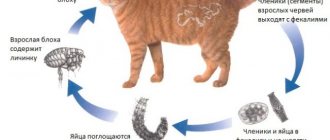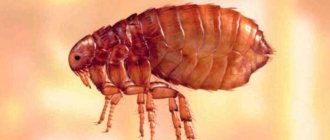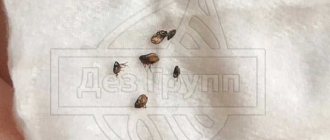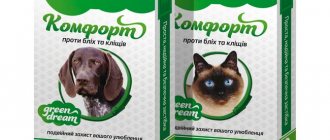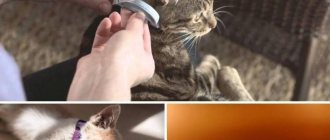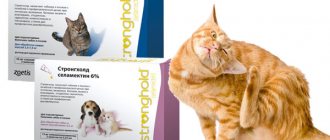Every owner encounters fleas or ticks on a cat from time to time - especially if the cat lives in the country in the summer. Worms in cats are also common, and deworming medications are also recommended after the summer season ends. What is the treatment for ticks in a cat, how to get rid of fleas and what deworming remedies to choose?
What types of parasites do cats have?
There are two main types of parasites dangerous to cats:
— external (fleas, ticks, lice, lice);
- internal (worms - tapeworms and roundworms).
Infection with each of these types of parasites has its own symptoms and treatment methods. And each of these parasites poses a danger, for example, if worms are not removed, then in the end this can even lead to death.
Read more about internal parasites: Worms in cats: symptoms and treatment
Symptoms of fleas and worms in kittens
Many owners believe that if bloodsuckers are not visible, then they are not there. This is a misconception. Fleas live in the environment; they only come to the animal’s body to feed.
You can suspect an invasion based on a number of indirect signs:
- comb;
- itching (the kitten is constantly itching, trying to rub against furniture);
- restless behavior.
Dark small crumbs are noticeable on the pet’s body - this is not dirt, but waste products of insects. If you comb out the grains onto a white sheet and moisten them with water, they will blur into brownish-red spots.
If the bloodsuckers are not removed, they will continue to reproduce. A large number of bites will lead to the development of anemia in the kitten. Due to continuous itching, the cub stops eating and sleeping normally and quickly loses weight.
In addition, fleas act as carriers of life-threatening infections, worms. Helminthiases in the early stages are asymptomatic. As the worms affect the internal organs, negative signs appear.
Depending on the type of parasite, the kitten may experience:
- diarrhea alternating with constipation;
- yellowness or paleness of the mucous membranes;
- bloating due to general exhaustion;
- excessive appetite (in later stages, refusal to eat is possible);
- deterioration in quality, hair loss;
- vomit;
- paroxysmal cough;
- rash;
- copious serous or purulent discharge from the eyes and nose;
- impurities of blood, mucus in the stool, and the release of helminths with feces or vomit.
Wormed kittens lag behind in growth and development compared to their peers. Worms can cause intestinal blockage and paralysis of the hind legs. If the baby is not treated, the consequences of helminthiasis will be irreversible. You need to get rid of them at the first sign of infestation.
Yuri Lizvinsky Veterinarian, head of the training department of Apicenna LLC
Routes of infection
External parasites in cats are also called ectoparasites. They live on the skin and fur of purrs. With their bites they cause anxiety, itching, dermatitis, and allergic reactions in the pet.
The main way a cat is infected with external parasites is through contact with an already infected animal. As a rule, this happens on the street while walking on your own. A cat can also pick up parasites from a dog living in the same house as dogs walk outside. The owner himself can bring parasites into the apartment on shoes or clothes. If after this he immediately (without washing his hands) strokes the cat or if it lies on the rug near the front door, then parasites may well get on it.
Finally, some parasites (for example, fleas) can enter your home themselves, even if you do not live on the first floor. With its ability to move, the flea will calmly jump to your apartment and enter the opening door with you (of course, this is much less likely than an infection on the street). Once in the apartment, the insect will multiply quickly. He doesn't have to do the masonry. Even while jumping, it can scatter eggs, shooting anywhere. Over time, the flea will settle on the cat.
A small kitten can be infected by a mother cat, and fleas live on kittens with great pleasure.
How to properly wash a kitten without causing him stress
Cats are afraid of water.
Bathing a kitten
To avoid causing your animal stress from bathing, you should adhere to the following rules:
- accustom him to water gradually, starting with wiping his paws. You cannot put a cat in the bath while water is pouring in. The sound of water will cause shock. Do not use brushes or sponges while bathing. Only light touching and stroking with hands is possible;
- When washing with shampoo, do not allow the soap solution to get into your eyes. Therefore, it is better not to wet the kitten’s head;
- the remnants of the shampoo should be washed off well so that the animal does not get poisoned after licking the water;
- Upon completion of bathing, the kitten should be wrapped in a terry towel and taken into the room.
Signs of External Parasites
The main sign of the presence of ectoparasites in a cat is severe itching, which becomes more pronounced every day. Because of this itching, the pet will vigorously scratch the bite area and try to comb insects out of its fur with its claws. The cat will also try to bite and gnaw at parasites and actively lick the fur.
Due to constant torment and discomfort, the cat becomes lethargic, irritable, stops listening to the owner, practically does not sleep at night, and refuses to play.
Alopecia, scratching, scratches, and redness appear on the fur and skin. In some cases, signs of allergic reactions may appear: the eyes become watery, the skin becomes covered with a rash and pustules.
Signs of fleas
Symptoms of parasites:
- Scratching and biting fur. On the skin of the animal you can find insect bites and wounds that the pet inflicted on itself when combing. Allergic reactions to flea bites are possible.
- Loss of appetite.
- Restless sleep. Fleas on a kitten interfere with your pet's sleep: during sleep, he often turns over from one side to the other, twitches his paws or jumps.
- Signs of exhaustion. Insects feed on the pet's blood, leading it to exhaustion.
The presence of parasites can also be detected by examining the animal.
Treatment for parasites
Read about how to treat a cat for internal parasites here: Preparations for deworming cats
In this article we will focus on what to do if your pet has external parasites (fleas, lice, lice). Please note that a veterinarian must make an accurate diagnosis and prescribe a course of treatment, even if it seems to you that the presence of certain parasites is obvious. You can even correctly identify their type, but the effectiveness of treatment depends on other factors: the age of the animal, its characteristics, the presence or absence of other diseases.
After prescribing therapy, the main condition that is important to observe is to use the chosen remedy strictly according to the instructions. This will effectively remove parasites without harming the cat.
Medicinal shampoos. As a rule, these funds are used first. They have an insecticidal effect, inhibiting the activity of insects. After applying shampoo to your pet’s fur and foaming, you should definitely wait a few minutes, usually 5 to 10 (it’s better to time the time by clock), and only then rinse off the shampoo. It should be borne in mind that different shampoos have different effects: some eliminate existing parasites, and some only repel insects (that is, they are used as a preventive measure).
Sprays. They also contain insecticides that effectively fight the disease. The spray can be used to treat not only the cat itself, but also its things (toys, beds, etc.). But be sure to make sure that she does not lick the preparation from the fur (until it dries completely)!
Drops on the withers. Can be used both for direct treatment and for preventive purposes. There is no need to be afraid that the cat will lick the drug. The effect of the drops lasts about 1-2 months when applied correctly: on dry, clean skin in the area between the shoulder blades or on the withers. Manufacturers recommend not bathing your cat a few days before applying the drug and a few days after.
Collars. This is the most durable and safest way to rid a kitten of parasites. It acts as gently as drops and shampoos. When choosing, pay special attention to the size and stiffness of the collar so that your pet feels comfortable in it.
Basic rules for treating a kitten for fleas
Before applying the anti-flea solution, you must carefully read the instructions and follow the recommendations indicated therein.
The method of processing depends on the form of the medicine:
- The drops should be poured from a special pipette onto the withers so that the furry patient cannot lick them off. It is forbidden to bathe the cat for three days before and after application;
- adjust the collar so that a finger fits between it and the neck;
- Distribute the shampoo evenly over the body, lather, wait 5-10 minutes. Rinse with plenty of running water and dry the fur thoroughly;
- Spread the sprays over the pile in the open air from a distance of 10-15 cm. They try not to treat cats in this way. It can be difficult to ensure that the animal does not lick itself until the substance is completely dry.
The frequency of procedures depends on the active ingredient of the drug and the pet’s lifestyle. Typically, preventative treatments are carried out every 1-3 months.
How to protect a cat from parasites
It is best not to remove parasites (external and internal), but to prevent their appearance at all. To do this, follow simple rules:
- Do not let your cat out of the house; on the street, in addition to parasites, other dangers await her.
Read more: Self-walking - when freedom means death
- The tray must be cleaned of dirt every day - feces should not remain there for more than a day.
- When completely changing the filler, the tray is thoroughly washed with hot water and soap (laundry soap works well).
- The cat must be provided with a high-quality and balanced diet. Professional super-premium and holistic-class foods are best suited, as they already contain all the necessary vitamins and minerals. The pets at the Murkosha shelter receive exactly this kind of food.
- Do not give your cat raw meat and fish - neither freezing nor scalding with boiling water guarantees the safety of the food.
Read more: Proper nutrition for cats
- Try to wean your cat from sitting on the rug by the front door.
- If possible, put your shoes in a closet or on a rack.
- Do wet cleaning regularly.
In addition, you still need to regularly treat your cat against external and internal parasites for preventive purposes.
The best anti-tick drops for kittens and cats
Preparations that are the best anti-tick drops for cats (according to reviews from real kitty owners):
- "Leopard". The solution is made on the basis of fipronil, which is part of the phenylpyrazoles group. This means that the component paralyzes the nervous system of ticks. The excipients in Bars drops are dicarboximide and diflubenzuron.
- "Beafar." Approved for kittens 3 months and older. Beafar is contraindicated for a younger kitten. The drops contain a natural insecticide called perethrin. An auxiliary component is margosa extract. The protective effect lasts one month.
- Celandine. A two-component product containing permethrin and fipronil. Their combined effect doubly affects the nervous system of parasites, accelerating their death. Ticks receive an increased dosage of poison.
Questions and answers
What is the composition of flea drops for cats?
Safe and effective components that are included in anti-parasitic drops for cats include imidacporil, silamectin and finpronil. The component that causes severe poisoning to the cat's body (even if the pet does not lick it off the fur) is permethrin.
What flea and worm drops for kittens are considered good?
Good drops against worms or fleas, suitable for small kittens, are “Inspector Mini”, “Advocate”, “Dironet Spot-On”, “Bravecto Plus”. The main thing is to correctly calculate the dosage, since the kitten is more susceptible to toxic substances.
Anthelmintic drops on the withers
One of the most convenient forms of application is drops that are applied to the withers. To do this, the animal’s fur is carefully parted, the area of skin is dried, and a strictly dosed amount of the drug is applied. As a rule, the products are produced in a disposable pipette, which makes the process of use easier.
The most well-known products in this group:
- Advocate.
- Dironet.
- Inspector.
After applying the drops, do not bathe the animal for 4 days, and do not stroke or pick up the pet. The dosage is selected by the doctor, taking into account individual characteristics.
A chemical drug from this group is recognized as the best deworming remedy for cats (strictly dosed, easy to use).
How is demodicosis of the eye transmitted?
Demodectic mange of the eyes can be contracted at home - by sharing hygiene items, towels, bed linen, and cosmetics with the patient.
To prevent re-infection, you need to change your pillowcase and towel (or use paper towels) daily, and throw away contaminated cosmetics.
To treat each eyelid, you must use a separate (new each time) cotton swab.
1 Diagnosis and treatment of demodicosis
2 Diagnosis and treatment of demodicosis
3 Treatment of demodicosis

